Abstract
Heat stress, as a negative factor, severely threatens the quality and production of bottle gourd, which prefers to grow in a warm environment. To understand which genes are involved in the resistance to heat stress in bottle gourd (Lagenaria siceraria (Mol.) Standl.), we analyzed the characteristics of two genetic bottle gourd varieties, “Mei feng”-MF (heat resistant) and “Lv long”-LL (heat sensitive). Under heat stress, MF plants exhibited a higher survival rate, lower relative electrolytic leakage, and decreased stomatal aperture compared with LL. In addition, RNA-Seq was carried out on the two varieties under normal conditions and heat stress. The results revealed a total of 1485 up-regulated and 946 down-regulated genes under normal conditions, while 602 genes were up-regulated and 1212 genes were down-regulated under heat stress. Among these genes, several differentially expressed genes (DEGs) involved in the MAPK (mitogen-activated protein kinase) signaling pathway and members of bHLH (basic helix-loop-helix) transcription factors showed significant up- or down-regulation after heat stress. Next, to validate these findings, we conducted quantitative real-time PCR (qRT-PCR) analysis, which confirmed the expression patterns of the genes detected through RNA-Seq. Collectively, the DEGs between the two contrasting cultivars identified in our study provide novel insight into excavating helpful candidate genes associated with heat tolerance in bottle gourd.
1. Introduction
Heat stress (HS) caused by high temperatures severely impacts plant growth, endangering ecosystem quality and agricultural production in many areas around the world. When plants are exposed to transitory or constantly high temperatures, there are multiple changes in physiological and biochemical facts, leading to drastic reductions in crop yield and quality [1]. In order to survive unfriendly conditions, plants have evolved several intrinsic strategies to adapt to HS [2]. Plant hormone changes, heat shock protein (HSP) protection, and reactive oxygen species (ROS) scavenging are involved in conferring tolerance to plants, especially at high temperatures [3,4,5]. The abscisic acid (ABA), ethylene, and jasmonic acid (JA) can affect plant adaptation to high temperatures [6], especially ABA. ABA is required for the accumulation of ascorbate peroxidase (APX1) during HS [7]. Previous studies have reported that ABA-deficient and -insensitive mutants are sensitive to high temperatures, while overexpressing ABRE (abscisic acid responsive elements) binding factors (ABF) can enhance plants’ thermotolerance [8]. Hydrogen peroxide exerts roles in increasing the ABA-dependent expression of heat shock protein 70 (HSP70) and enhancing the tolerance of plants to heat stress [9]. In rice, the HEAT TOLERANCE AT SEEDLING STAGE (OsHTAS) gene, encoding a ring finger ubiquitin E3 ligase, can increase heat tolerance by regulating H2O2-induced stomatal closure [10].
Most vegetables prefer to grow under warm conditions; thus, they do not possess the ability to tolerate HS. For example, when the temperature is over 35 °C, cucumber plants bear severe thermal damage [11]. However, previous studies have shown that many genes are also involved in HS responses in vegetables. For instance, ectopic expression of spinach betaine aldehyde dehydrogenase (BADH) in tobacco improves plant thermotolerance [12]. Pepper heat shock protein 24 (CaHSP24), which is significantly induced by high temperatures, plays a crucial role in heat tolerance [13]. HSP70, which is prominently induced by ABA, increases heat tolerance in cucumber [14]. Overexpression of CsCaM3 (Calmodulin 3) in cucumber plants leads to improved heat tolerance by regulating the expression of heat-responsive genes [15].
African-native bottle gourd (Lagenaria siceraria (Mol.) Standl.), also known as calabash or opo squash, is grown worldwide for its medicinal, decorative, and grafting rootstock properties [16]. Previous studies have demonstrated that bottle gourd exhibits some level of drought and salinity tolerance compared to other cucurbits [17,18]; hence, it is widely used as a rootstock for watermelon and melon. Bottle gourd prefers to grow in a warm environment (25–35 °C), without higher temperature resistance. When exposed to high temperature conditions (normally > 40 °C), especially in the seedling stage, the development, quality, and yield are seriously affected. However, few genes have been explored related to HS resistance in bottle gourd, which restricts crucial gene application in heat resistance genetic breeding of bottle gourd. Our study aims to explore the responses of some important genes to heat stress by transcriptome sequencing, which will not only provide insights into the molecular mechanisms underlying HS responses in bottle gourd but also highlight the involvement of genes in conferring heat tolerance.
2. Materials and Methods
2.1. Plant Materials and Heat Stress Treatment
In 2018, a total of 120 bottle gourd varieties were exposed to high temperatures (45 °C/40 °C in day/night) for 7 days in a phytotron room. Combining plant phenotype and survival rate, we obtained several heat-resistant and -sensitive varieties, including MF and LL (data unpublished). MF with heat tolerance and LL with heat sensitivity were used in this study. MF and LL were homozygous inbred lines derived from the native variety “Fuzhou bottle gourd” and “Hubei bottle gourd”, respectively. “Fuzhou bottle gourd” is a commonly cultivated inbred variety in Fujian province, while “Hubei bottle gourd” is an inbred cultivar grown in the central region of China. The seeds were soaked in warm water at 50 °C for 20 min, followed by soaking in room temperature water for 10 h. Subsequently, the seeds were germinated in an incubator at a temperature range of 30~32 °C under dark conditions for 2 days. Subsequently, the pre-germinated MF and LL seeds were grown in an artificial climate box maintained at 30 °C/24 °C day/night temperature (5500 lux, 60% RH). When plants were grown to one true leaf stage (14-day seedling stage), they were exposed to heat treatment for 7 days (45 °C/40 °C in day/night) and recovered at room temperature for 3 days. Each cultivar contained 24 plants, with three biological replicates.
2.2. Stomatal Aperture Analyses
To view the stomatal aperture using scanning electron microscopy (SEM), the abaxial epidermises of true leaves of HS (consecutively exposed to 45 °C for 24 h) or mock-treated plants were prepared following standard procedures [19]. Leaf samples were immersed in 5% glutaraldehyde overnight, washed in 0.1 M phosphate buffer (pH 7.0), and then treated in 1% osmium tetroxide for 2 h. The samples were dehydrated using serially diluted ethanol (70% to 100%) and isoamyl acetate. Specimens were dried in a Hitachi HCP-2 critical point dryer (Hitachi High-Tech, Tokyo, Japan) with liquid CO2 and mounted onto double-coated carbon conductive tapes attached to specimen holders. Samples were sputter-coated with gold-platinum and examined using a Hitachi TM-1000 TSEM (Hitachi High-Tech, Tokyo, Japan). Twenty stomata were randomly chosen for measurement in each leaf. Five plants were analyzed per treatment, and two independent experiments were performed, showing similar results.
2.3. Transcriptome Sequencing
Total RNA was extracted from the true leaves of MF and LL according to the instruction manual of the TRlzol Reagent (Life Technologies, Carlsbad, CA, USA). RNA integrity and concentration were checked by gel electrophoresis and Nanodrop quantification. mRNA was isolated by the NEBNext Poly (A) mRNA Magnetic Isolation Module (NEB, MA, UK; E7490). The cDNA library was constructed following the manufacturer’s instructions of the NEBNext Ultra RNA Library Prep Kit for Illumina (NEB, ipswitch, MA, UK; E7530) and NEBNext Multiplex Oligos for Illumina (NEB, ipswitch, MA, UK; E7500). In brief, the enriched mRNA was fragmented into approximately 200 nt RNA inserts, which were used to synthesize the first-strand cDNA and the second cDNA. End-repair/dA-tail and adaptor ligation were performed on the double-stranded cDNA. The suitable fragments were isolated using Agencourt AMPure XP beads (Beckman Coulter, Inc., Brea, CA, USA) and enriched by PCR amplification. Finally, the constructed cDNA libraries of the bottle gourd leaves were sequenced on a flow cell using an Illumina HiSeq™ sequencing platform.
2.4. Bioinformatic Analysis of RNA-Seq Data
The low-quality reads, like adaptors, unknown nucleotides > 5%, or Q20 < 20% (percentage of sequences with sequencing error rates < 1%) were removed by perl script. The clean reads were mapped to the Bottle Gourd reference genome (http://cucurbitgenomics.org/v2/organism/29, (accessed on 10 October 2023)) using TopHat2 software (http://ccb.jhu.edu/software/tophat, (accessed on 10 October 2023)). The transcript level of each gene was calculated using FPKM values (fragments per kilobase of exon per million fragments mapped) by Cufflinks 2.2.1 software. Genes with a false discovery rates (FDR) < 0.05 and fold change values > 1.5 were regarded as differentially expressed genes (DEGs). Only genes with an absolute value of log2 ratio ≥ 1.5 and FDR significance score < 0.05 were used for subsequent analysis.
For the gene annotation and classification assay, the BLASTX program was used in various protein databases, including the National Center for Biotechnology Information (NCBI) non-redundant protein (Nr) database and the Swiss-Prot database with a cut-off E-value of 10−5. Genes were retrieved based on the best BLAST hit (highest score), along with their protein functional annotation. To annotate the genes with Gene Ontology (GO) terms, the Nr BLAST results were imported into the WEGO program [20]. The obtained annotation was enriched and refined using TopGo (R package). Pathway assignments were made by mapping the unigenes onto KEGG categories (http://www.genome.jp/kegg/ (accessed on 10 October 2023)) [21]. Raw sequencing data were archived under accession numbers SRR24414144-SRR24414143-SRR24414132 (MF-CK), SRR24414127-SRR24414126-SRR24414125 (LL-CK), SRR24414140-SRR24414139-SRR24414138 (MF-HS), and SRR24414137-SRR24414136-SRR24414135 (LL-HS) in the NCBI Sequence Read Archive (SRA, http://www.ncbi.nlm.nih.gov/Traces/sra, (accessed on 10 October 2023)).
2.5. Quantitative Real-Time PCR (qRT-PCR)
About 2 μg total RNA was used to generate cDNA using the TransScript® One-Step gDNA Removal and cDNA Synthesis SuperMix (TransGen, Beijing, China) according to the manufacturer’s instructions. As a template, 150 ng of synthesized cDNA was used to perform RT–qPCR analysis. PCR reactions were performed in a total volume of 20 μL, with 1 μL of each primer (final concentration 200 nM) and 10 μL of SYBR Green Master Mix (Takara Bio, Beijing, China). The PCR program included an initial denaturation step at 94 °C for 3 min, followed by 40 cycles of 30 s at 94 °C and 35 s at 60 °C. Each sample was quantified in triplicate and normalized using TuB-α gene [22] as internal controls. Three biological replicates were performed, and three technical repeats were performed for each biological replicate. The primer pairs for RT–qPCR are listed in Table S1. The relative expression levels were normalized to the TuB-α and calculated using the 2−ΔΔCT method.
3. Results
3.1. MF Is a Resistant Cultivar to Heat Stress
MM and LL (24 plants for three biological replicates, respectively) were grown to the one true leaf stage under normal conditions (Figure 1A). Then, they were transferred to high temperature conditions (45 °C) for 7 days (Figure 1B) and recovered for 3 days (Figure 1C). Before treatment, both MM and LL thrived exuberantly; however, the top growth point of LL showed wilting symptoms after heat stress, and its cotyledons and true leaves turned chlorotic and yellow (Figure 1A,B). After recovery, most LL plants were dead, while some MF plants exhibiting continued growth (Figure 1C). Approximately 82% of MF plants survived after heat stress treatment in comparison with about 21% of LL plants (Figure 1D). In addition, we found that the relative electrolytic leakage in the surviving seedlings was significantly higher in LL compared to MF (Figure 1E). Previous studies reported that the stomatal aperture exerts crucial roles in abiotic stress [22,23]. In order to determine the difference in stomatal aperture between MF and LL, we used scanning electron microscopy (SEM) to carry out the assay. The results showed that the stomatal opening was similar in MF and LL plants under normal conditions. However, when the plants were treated with HS, the stomatal opening was noticeably smaller in MF than in LL (Figure 2A,B). Taken together, these findings suggest that LL and MF are susceptible and resistant cultivars, respectively, in response to HS.
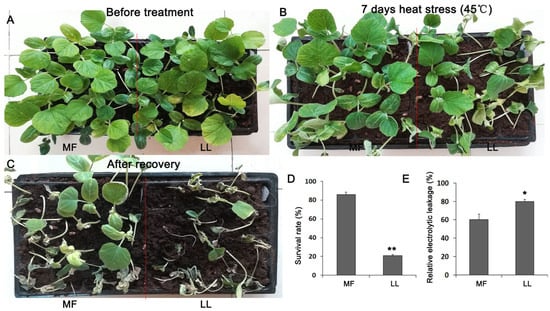
Figure 1.
Phenotypes of MF and LL under HS treatment. (A) MF and LL plants before treatment. (B) MF and LL plants exposed to HS treatment for 7 days. (C) MF and LL plants after recovery. (D) Survival rates of MF and LL after heat stress treatment. (E) Relative electrolytic leakage under normal conditions. Data are presented as the mean ± SD (n = 9). ** p < 0.01, * 0.01 < p < 0.05; Student’s t-test.
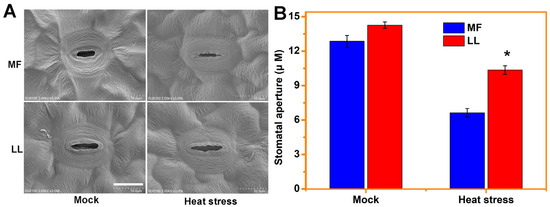
Figure 2.
HS decreases the stomatal aperture in MF leaves. Representative SEM image of stomata of MF and LL true leaves in response to HS (A); the stomatal aperture data are shown in (B). Values are the means ± SD. Data from two independent experiments showed similar results. The results of one representative experiment are shown, n = 20 for each treatment group. The asterisk indicates a significant difference between the treatments (Student’s t-test, p < 0.05).
3.2. Heat Stress-Induced Transcriptional Changes
In order to study the molecular response to heat stress between MM and LL, we carried out transcriptome sequencing of these two varieties under normal conditions (CK) and after 24 h heat stress treatment (H). Three biological replicates from each treatment were obtained. More than 43 million reads and over 92% of clean reads were obtained from each sample after removing the low-quality and adaptor-containing reads (Table 1). At least 6.9 Gb clean bases were acquired from each sample (Table 1). The number of base recognition accuracies over 99.9% was no less than 6.2 Gb (Table 1). Over 92.3% of the clean reads were totally mapped to the reference bottle gourd genome [23], with more than 97.6% being uniquely mapped (Table S2). After normalization using total reads, we finally identified 2431 (normal condition, CK) and 1814 (heat stress, H) differentially expressed genes (DEGs) (Figure 3). Among them, a total of 1485 genes were up-regulated and 946 genes were down-regulated before HS treatment (Table S3, Figure 3), while 602 genes were up-regulated and 1212 genes were down-regulated in response to HS (Table S4, Figure 3). Furthermore, to validate the RNA-seq results, a total of 21 genes, which showed significantly up- or down-regulation with the absolute value Log2 fold change > 1 after HS treatment (Table S1), were randomly selected and used for qRT-PCR analysis. The results showed that a strong positive correlation (two tailed, R2 = 0.938) was detected between MF and LL (Figure 4), indicating the accuracy of the RNA-seq data.

Table 1.
Analysis of raw data between MF and LL under normal conditions (CK) and 24 h after heat stress (H).
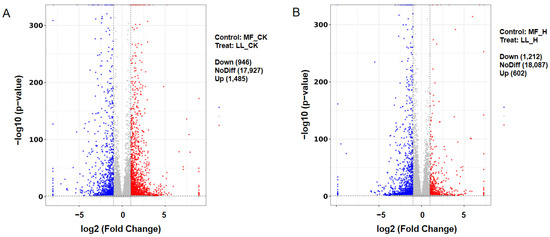
Figure 3.
Differentially expressed gene (DEG) analysis in leaves under normal conditions (CK) and 24 h after heat stress (H). (A). DEGs under normal conditions. (B). DEGs after 24 h of heat stress. Red, brown, and blue represent up-regulated, no-difference, and down-regulated gene expression, respectively.
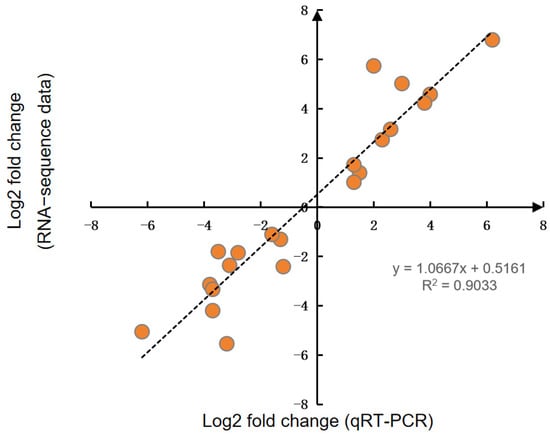
Figure 4.
Validation of DEGs by qRT-PCR. The orange circles represent different gene expressions.
3.3. Enriched Gene Categories Related to Heat Stress
In order to understand which categories are represented in DEGs in comparison with the bottle gourd genome, all 2431 (CK) and 1814 (H) genes were further analyzed for Gene Ontology (GO) functional annotations. The results showed that three categories “cellular components (CC)”, “molecular function (MF)”, and “biological process (BP)” were classified under normal conditions (Table S5) and heat stress (Table S6) between MF and LL. The number of CC and BP were prominently decreased after heat treatment, while the number of genes in the MF category were significantly increased, especially in endopeptidase inhibitor activity, peptidase inhibitor activity, and so on (Figure S1).
Next, to examine the obtained DEGs associated with different pathways, the KEGG pathway database was used. The results showed that the main pathways under normal conditions were “phenylpropanoid biosynthesis”, “plant hormones signal transduction”, and “amino sugar and nucleotide sugar metabolism” (Figure 5A). When exposed to heat stress, genes related to the “MAPK signaling pathway” and “photosynthesis” were mostly enriched (Figure 5B), while the pathway of “phenylpropanoid biosynthesis” was also enriched in heat stress.
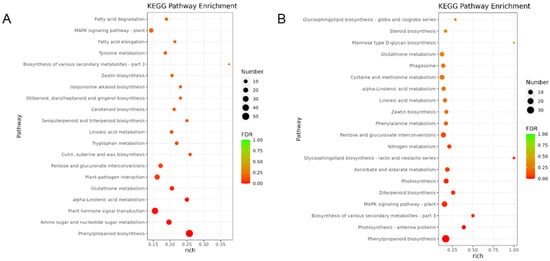
Figure 5.
KEGG analysis of DEGs under normal conditions (CK) and 24 h after heat stress (H). (A). DEGs under normal conditions. (B). DEGs after 24 h of heat stress. High and low FDR (false discovery rate) are represented by green and red, respectively.
3.4. Expression of bHLH-Related Genes under Heat Stress
In order to study the number and types of transcription factors (TFs) that changed after heat stress treatment, transcriptome data were further analyzed. The results showed that the expression of various TFs, including bHLH, ERF (ETHYLENE RESPONSE FACTOR), and NAC (NAM, ATAF, and CUC), were significantly changed under CK (Figure S2A). After heat stress treatment, most TFs, such as bHLH and ERF, were down-regulated compared to normal conditions (Figure S2B). Indeed, the basic helix-loop-helix (bHLH) superfamily plays important roles in normal plant growth and development, as well as function in response to biotic or abiotic stress [24,25]. Thus, we analyzed the expression of members of the bHLH family using RNA-Seq data. As shown in Table S7, almost all bHLH family genes exhibited a higher level of transcripts in MF compared to LL after HS treatment. Next, we randomly selected six bHLH genes from RNA-Seq data for qRT-PCR in detail. For the qRT-PCR assay, we detected bHLH expression after exposure to 12, 24, and 36 h HS and under normal conditions (CK). The results showed that these 6 bHLHs were significantly induced after 24 h HS treatment (Figure 6). HG10006168, HG10004527, and HG10015989 showed increased expression in MF compared with LL after 12 and 24 h of heat treatment. Among them, the expression of HG10004527 was significantly higher in MF than LL under normal conditions. HG10008149, HG10020341, and HG10006039 were highly expressed in LL in comparison with MF after 24 h heat stress treatment. HG10006039 also exerted higher expression in MF than LL under normal conditions (Figure 6).
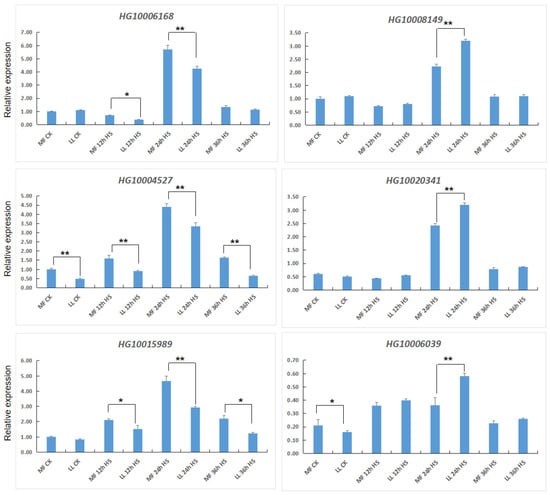
Figure 6.
Relative expression of bHLH transcription factors. Total RNA was extracted from the true leaves of MF and LL growing under normal conditions (CK) and heat stress (H). TuB-α was used as an internal control. Data are the means ± SD of three independent replicates. Asterisks indicate a significant difference between treatments (* 0.01 ≤ p ≤ 0.05, ** p ≤ 0.01, Student’s t test).
3.5. Expression of MAPK-Related Genes under Heat Stress
Based on KEGG analysis, we found that the MAPK (mitogen-activated protein kinase) signaling pathway was enriched during heat stress. Consistent with this observation, the expression of MAPK-related genes was significantly changed in the MF and LL seedlings under HS treatment (Table S7). Next, in order to understand the MAPK gene expression level in detail, 6 genes (Table S7) involved in the MAPK signal pathway were selected for qRT-PCR assay. The results showed that except HG1000206, the other five genes were significantly up-regulated in LL compared to MF after 24 h of heat stress treatment (Figure 7). Among them, gene expression of HG10000206, HG10006437, HG10008395, and HG10005867 was prominently higher in MF compared with LL after 36 h heat stress. All of these genes showed no differences in expression between MF and LL under normal conditions (Figure 7).
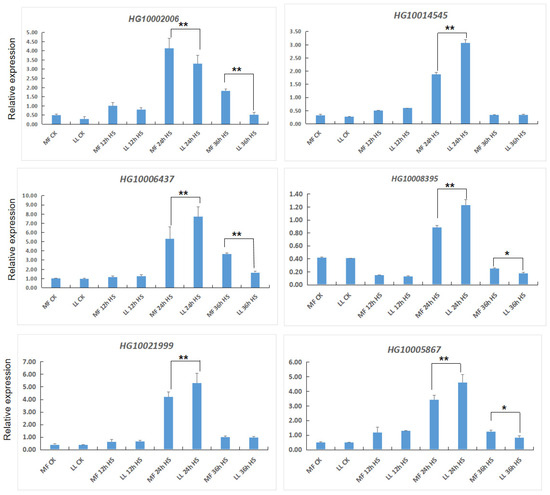
Figure 7.
Relative expression of MAPK genes. Total RNA was extracted from the true leaves of MF and LL growing under normal conditions (CK) and heat stress (H). TuB-α was used as an internal control. Data are means ± SD of three independent replicates. Asterisks indicate a significant difference between treatments (* 0.01 ≤ p ≤ 0.05, ** p ≤ 0.01, Student’s t-test).
4. Discussion
Heat stress severely limits crop production [26] by directly causing damage to enzymes and tissues [27], impairing flowering [28], and triggering oxidative stress at the plant reproductive stage [29]. It has been reported that many crop species are sensitive to heat stress, which ultimately impacts the economies of countries by reducing crop production [30]. Bottle gourd, as one of the most popular vegetables in South China, is pretty sensitive to heat stress, which leads to a decrease in production and quality. In our study, we used heat-resistant (MF) and heat-sensitive (LL) varieties to perform an RNA-sequencing assay. We found that the number of DEGs increased significantly 24 h after heat stress treatment. Among them, several DEGs related to the bHLH and MAPK signaling pathways showed prominent expression changes between MF and LL.
4.1. Analysis of bHLHs under Heat Stress
Transcription factors (TFs), such as WRKY [31], MYB [32], basic leucine zipper (bZIP) [33], and basic helix-loop-helix (bHLH) families, exert crucial roles in resistance to biotic and abiotic stress [34]. Among them, bHLHs are the second largest families and positively or negatively regulate plant resistance to various stressors [24,25]. For instance, bHLH2 positively regulates cold stress in Tartary buckwheat [35]. Overexpression of rice OsbHLH001 confers freezing and salt tolerance in transgenic Arabidopsis [36]. Overexpressing grape VvbHLH1 significantly improves salt and drought tolerance in transgenic Arabidopsis [2]. OsbHLH148 increases drought resistance in rice [37]. Our study detected that the expression of several bHLHs changed significantly between MF and LL after heat stress treatment. Among them, three genes, HG10006168, HG10004527, and HG10015989, exerted high expression in MF compared with LL after 24 h of heat stress treatment. Similar findings have been observed in other plants. For example, the expression of Suaeda salsa bHLH35 (the homolog of HG10006168) was significantly up-regulated after HS treatment [38]. In eggplant, the transcript levels of bHLH35 were also found to be up-regulated at 38 °C for 3 h and 6 h [39]. Additionally, heterologous expression of Anthurium andraeanum bHLH35 has been shown to improve tolerance to cold and drought stress in Arabidopsis [40]. Collectively, these results suggest that HG10006168 may play a positive role in HS resistance in bottle gourds. Like bHLH35, the expression of bHLH93 (the homolog of HG10004527) was also induced by different stressors [41,42]. However, functional analysis in Arabidopsis showed that bHLH93 is a key factor required for the promotion of flowering under non-inductive short-day conditions through the GA signaling pathway [43]. Consistent with these data, the expression of HG10004527 was found to be higher in the ovary compared to roots and leaves, suggesting the potential role of this gene during the development of bottle gourd. Nevertheless, further research is needed to explore the functions of these genes in detail.
4.2. Analysis of the MAPK Signal Pathway under Stress
When plants are exposed to abiotic stress, many regulatory processes are controlled by many signaling pathways. Among them, MAPK (mitogen-activated protein kinase) exerts central roles during the stress resistance process [44,45]. MAPKs, as the evolutionarily conserved proteins in all eukaryotes, can be activated by substantially diverse stressors, and the activation of multiple MAPK pathways orchestrates fundamental cellular processes [46,47]. Previous studies have shown that the expression of MAPK-related genes, such as MAPK2, MAPK3, and MAPK16, is induced by abiotic stress treatments. Overexpression of MAPK16 increases drought tolerance in Arabidopsis [48]. MAPK3 positively enhances resistance under cold, drought, and salt stress in Arabidopsis [49]. In tobacco, MAPK2 positively regulates salt and drought tolerance in tobacco [50]. In our study, we detected 6 MAPK-related genes, which were differentially expressed between MF and LL. Among them, five genes (HG10014545, HG10006437, HG10008395, HG10021999, and HG10005867) were significantly increased much more in LL than MF after 24 h heat stress treatment, indicating that these five genes might be involved in heat resistance of bottle gourd seedlings. Indeed, Arabidopsis MAPK9, which is the homolog of HG10014545 and HG10008395, functions redundantly with another member of the MAPK family, MAPK12, as a positive regulator in ABA- and JA-induced stomatal closure [51]. This suggests that MAPK9 and MAPK12 regulate guard cell function in ABA signaling downstream of ROS. Moreover, further studies imply that MAPK9 and MAPK12 are positive regulators of SA signaling in Arabidopsis guard cells [52]. This finding is consistent with the role of MAPK9 and MAPK12 in regulating stomatal apertures, which contribute to the plant’s defense against pathogens [53]. Arabidopsis MAP KINASE KINASE KINASE 1 (MAPKKK1), which is the homolog of HG10006437, is a key transduction element that coordinates damage- and pathogen-associated molecular pattern-triggered immunity and orchestrate reactive oxygen species accumulation and signaling [54]. A subsequent study indicated a change in the localization pattern of MAPKKK1 from the cytosol to plastids and nuclei after elicitor perception [55]. The function of MAPK9, MAPK12, and MAPKKK1 in biotic stress response suggested that HG10014545, HG10008395, and HG10006437 may also have a similar function in bottle gourd. Further study is required to investigate the specific role of these genes in bottle gourd and their potential involvement in the plant’s defense mechanisms against pathogens.
5. Conclusions
In this study, we first identified a heat-resistant variety of bottle gourd that exhibited a higher survival rate, lower relative electrolytic leakage, and decreased stomatal aperture under HS. Next, RNA-Seq data showed that approximately 2000 genes were significantly altered under HS treatment compared to normal conditions in both heat-resistant and heat-sensitive varieties. Among these genes, several were found to be involved in the MAPK (mitogen-activated protein kinase) signaling pathway, as well as members of bHLH transcription factors, which showed significant up- or down-regulation after HS, which was further confirmed by real-time PCR (qRT-PCR) analysis. Our work may provide crucial genes for understanding the molecular regulation of heat resistance, which would be helpful in genetically improving heat tolerance in bottle gourd breeding.
Supplementary Materials
The following supporting information can be downloaded at: https://www.mdpi.com/article/10.3390/agronomy14020299/s1, Figure S1: GO analysis of DEGs under normal condition and 24 h after heat stress; Figure S2: Transcription factor analysis under normal conditions and 24 h after heat stress; Table S1: Primers used in this study; Table S2: The summary of sequence analysis; Table S3: The DEGs under normal conditions between MF and LL; Table S4: The DEGs under HS between MF and LL; Table S5: GO analysis of DEGs under normal conditions between MF and LL; Table S6: GO analysis of DEGs under HS between MF and LL; Table S7: DEGs of MAPK-related genes and members of bHLH transcription factors between MF and LL before and after treatment.
Author Contributions
Conceptualization, S.Y.; methodology, Q.P., B.J. and Y.L.; formal analysis, S.S., Y.W. and L.C.; investigation, T.Z. and X.C.; writing—original draft preparation, M.W.; writing—review and editing, M.W. and W.L. All authors have read and agreed to the published version of the manuscript.
Funding
This work was supported by the Agricultural Competitive Industry Discipline Team Building Project of Guangdong Academy of Agricultural Sciences (202114TD, 202103TD) and the Key-Area Research and Development Program of Guangdong Province (2022B0202110003). The funding agencies played no role in the design of the study, data collection, analysis, interpretation, or writing of the manuscript.
Data Availability Statement
The datasets generated for this study are accessible upon request from the authors.
Acknowledgments
We are grateful to Fachao Shi (Institute of Fruit Tree Research, Guangdong Academy of Agricultural Sciences) for the assistance in data analysis and phenotype identification.
Conflicts of Interest
The authors declare no conflicts of interest.
References
- Wahid, A.; Gelani, S.; Ashraf, M.; Foolad, M.R. Heat tolerance in plants: An overview. Environ. Exp. Bot. 2007, 61, 199–223. [Google Scholar] [CrossRef]
- Wang, D.; Qin, B.X.; Li, X.; Tang, D.; Zhang, Y.; Cheng, Z.K.; Xue, Y.B. Nucleolar DEAD-Box RNA helicase TOGR1 regulates thermotolerant growth as a Pre-rRNA chaperone in rice. PLoS Genet. 2016, 12, e1005844. [Google Scholar] [CrossRef]
- McClung, C.R.; Davis, S.J. Ambient thermometers in plants: From physiological outputs towards mechanisms of thermal sensing. Curr. Biol. 2010, 20, 1086–1092. [Google Scholar] [CrossRef]
- Mittler, R.; Finka, A.; Goloubinoff, P. How do plants feel the heat? Trends Biochem. Sci. 2012, 37, 118–125. [Google Scholar] [CrossRef]
- Bita, C.E.; Gerats, T. Plant tolerance to high temperature in a changing environment: Scientific fundamentals and production of heat stress-tolerant crops. Front. Plant Sci. 2013, 4, 273. [Google Scholar] [CrossRef]
- Zhu, J.K. Abiotic stress signaling and responses in plants. Cell 2016, 167, 313–324. [Google Scholar] [CrossRef]
- Zandalinas, S.I.; Damián, B.; Vicent, A.; Aurelio, G.C.; Inupakutika, M.A.; Ron, M. ABA is required for the accumulation of APX1 and MBF1c during a combination of water deficit and heat stress. J. Exp. Bot. 2016, 67, 5381–5390. [Google Scholar] [CrossRef]
- Larkindale, J.; Hall, J.D.; Knight, M.R.; Vierling, E. Heat Stress Phenotypes of Arabidopsis Mutants Implicate Multiple Signaling Pathways in the Acquisition of Thermotolerance. Plant Physiol. 2005, 138, 882–897. [Google Scholar] [CrossRef]
- Shinozaki, K.; Yamaguchi-Shinozaki, K. Gene networks involved in drought stress response and tolerance. J. Exp. Bot. 2007, 58, 221–227. [Google Scholar] [CrossRef]
- Liu, J.P.; Zhang, C.C.; Wei, C.C.; Liu, X.; Wang, M.G.; Yu, F.F.; Xie, Q.; Tu, J.M. The RING finger ubiquitin E3 ligase OsHTAS enhances heat tolerance by promoting H2O2-induced stomatal closure in rice. Plant Physiol. 2015, 170, 429–443. [Google Scholar] [CrossRef]
- Takabatake, R.; Karita, E.; Seo, S.; Mitsuhara, I.; Kuchitsu, K.; Ohashi, Y. Pathogen-induced calmodulin isoforms in basal resistance against bacterial and fungal pathogens in tobacco. Plant Cell Physiol. 2007, 48, 414–423. [Google Scholar] [CrossRef]
- Yang, X.H.; Liang, Z.; Lu, C.M. Genetic engineering of the biosynthesis of glycinebetaine enhances photosynthesis against high temperature stress in transgenic tobacco plants. Plant Physiol. 2005, 138, 2299–2309. [Google Scholar] [CrossRef]
- Zhu, W.; Lu, M.H.; Gong, Z.H.; Chen, R.G. Cloning and expression of a small heat shock protein gene CaHSP24 from pepper under abiotic stress. Afr. J. Biotechnol. 2011, 10, 4968–4976. [Google Scholar]
- Li, H.; Liu, S.S.; Yi, C.Y.; Wang, F.; Zhou, J.; Xia, X.J.; Shi, K.; Zhou, Y.H.; Yu, J.Q. Hydrogen peroxide mediates abscisic acid-induced HSP70 accumulation and heat tolerance in grafted cucumber plants. Plant Cell Environ. 2015, 37, 2768–2780. [Google Scholar] [CrossRef]
- Yu, B.W.; Yan, S.S.; Zhou, H.Y.; Dong, R.; Lei, J.J.; Chen, C.M.; Cao, B.H. Overexpression of CsCaM3 Improves High Temperature Tolerance in Cucumber. Front. Plant Sci. 2018, 9, 797. [Google Scholar] [CrossRef]
- Erickson, D.L.; Smith, B.D.; Clarke, A.C.; Sandweiss, D.H.; Tuross, N. An Asian origin for a 10,000-year-old domesticated plant in the Americas. Proc. Natl. Acad. Sci. USA 2005, 102, 18315–18320. [Google Scholar] [CrossRef]
- Mashilo, J.; Odindo, A.O.; Shimelis, H.A.; Musenge, P.; Tesfay, S.Z.; Magwaza, L.S. Photosynthetic response of bottle gourd [Lagenaria siceraria (Molina) Standl.] to drought stress: Relationship between cucurbitacins accumulation and drought tolerance. Sci. Hortic. 2018, 231, 133–143. [Google Scholar] [CrossRef]
- Yang, Y.; Yu, L.; Wang, L.; Guo, S. Bottle gourd rootstock-grafting promotes photosynthesis by regulating the stomata and non-stomata performances in leaves of watermelon seedlings under NaCl stress. J. Plant Physiol. 2015, 186, 50–58. [Google Scholar] [CrossRef]
- Singh, A.P.; Singh, T.; Rickard, C.L. Visualising impregnated chitosan in Pinus radiata early wood cells using light and scanning electron microscopy. Micron 2010, 41, 263–267. [Google Scholar] [CrossRef]
- Ye, J.; Fang, L.; Zheng, H.K.; Zhang, Y.; Chen, J.; Zhang, Z.J.; Wang, J.; Li, S.T.; Li, R.Q.; Bolund, L.; et al. WEGO, A web tool for plotting GO annotations. Nocleic Acids Res. 2006, 34, 293–297. [Google Scholar] [CrossRef] [PubMed]
- Kanehisa, M.; Goto, S.; Kawashima, S.; Okuno, Y.; Hattori, M. The KEGG resource for deciphering the genome. Nucleic Acids Res. 2004, 32, 277–280. [Google Scholar] [CrossRef]
- Li, Y.W.; Wang, Y.; Wu, X.Y.; Wang, J.; Wu, X.H.; Wang, B.G.; Lu, Z.F.; Li, G.J. Novel genomic regions of fusarium wilt resistance in bottle gourd [Lagenaria siceraria (Mol.) Standl.] Discovered in Genome-Wide Association Study. Front. Plant Sci. 2021, 12, 650157. [Google Scholar] [CrossRef]
- Xu, P.; Wang, Y.; Sun, F.S.; Wu, R.L.; Du, H.L.; Wang, Y.H.; Jiang, L.B.; Wu, X.H.; Wu, X.Y.; Yang, L.M.; et al. Long-read genome assembly and genetic architecture of fruit shape in the bottle gourd. Plant J. 2021, 107, 956–968. [Google Scholar] [CrossRef]
- Duek, P.D.; Fankhauser, C. bHLH class transcription factors take centre stage in phytochrome signalling. Trends Plant Sci. 2005, 10, 51–54. [Google Scholar] [CrossRef]
- Feller, A.; Machemer, K.; Braun, E.L.; Grotewold, E. Evolutionary and comparative analysis of MYB and bHLH plant transcription factors. Plant J. 2011, 66, 94–116. [Google Scholar] [CrossRef]
- Cao, Z.B.; Tang, H.W.; Cai, Y.H.; Zeng, B.H.; Zhao, J.L.; Tang, X.Y.; Lu, M.; Wang, H.M.; Zhu, X.J.; Wu, X.F.; et al. Natural variation of HTH5 from wild rice, Oryza rufipogon Griff., is involved in conferring high-temperature tolerance at the heading stage. Plant Biotechnol. 2022, 20, 1591–1605. [Google Scholar] [CrossRef] [PubMed]
- Moore, C.E.; Meacham-Hensold, K.; Lemonnier, P.; Slattery, R.A.; Benjamin, C.; Bernacchi, C.J.; Lawson, T.; Cavanagh, A.P. The effect of increasing temperature on crop photosynthesis: From enzymes to ecosystems. J. Exp. Bot. 2021, 72, 2822–2844. [Google Scholar] [CrossRef]
- Tian, Y.L.; Chen, J.; Chen, C.Q.; Deng, A.X.; Song, Z.W.; Zheng, C.Y.; Willem, H.M.; Zhang, W.J. Warming impacts on winter wheat phenophase and grain yield under field conditions in Yangtze delta plain, China. Field Crops Res. 2012, 134, 193–199. [Google Scholar] [CrossRef]
- Khan, A.H.; Ma, Y.Z.; Wu, Y.L.; Akbar, A.D.; Shaban, M.H.; Ullah, A.B.; Deng, J.W.; Khan, A.S.; Chi, H.B.; Zhu, L.F.; et al. High-temperature stress suppresses allene oxide cyclase 2 and causes male sterility in cotton by disrupting jasmonic acid signaling. Crop J. 2023, 11, 33–45. [Google Scholar] [CrossRef]
- Abbas, S. Climate change and major crop production: Evidence from Pakistan. Environ. Sci. Pollut. Res. 2022, 29, 5406–5414. [Google Scholar] [CrossRef]
- Yokotani, N.; Sato, Y.; Tanabe, S.; Chujo, T.; Shimizu, T.; Okada, K.; Yamane, H.; Shimono, M.; Sugano, S.; Takatsuji, H.; et al. WRKY76 is a rice transcriptional repressor playing opposite roles in blast disease resistance and cold stress tolerance. J. Exp. Bot. 2013, 64, 5085–5097. [Google Scholar] [CrossRef]
- Chen, N.; Chi, X.Y.; Pan, L.J.; Yu, S.L. Advances in MYB transcription factors during salt-stress regulation in plants. Plant Physiol. J. 2015, 51, 1395–1399. [Google Scholar]
- Ma, H.Z.; Liu, C.; Li, Z.X.; Ran, Q.J.; Xie, G.N.; Wang, B.M.; Fang, S.; Chu, J.F.; Zhang, J.R. ZmbZIP4 contributes to stress resistance in maize by regulating ABA synthesis and root development. Plant Physiol. 2018, 178, 753–770. [Google Scholar] [CrossRef]
- Toledo-Ortiz, G.; Huq, E.; Quail, P.H. The Arabidopsis basic/helix-loop-helix transcription factor family. Plant Cell 2003, 15, 1749–1770. [Google Scholar] [CrossRef]
- Yao, P.F.; Sun, Z.X.; Li, C.L.; Zhao, X.R.; Li, M.F.; Deng, R.Y.; Huang, Y.J.; Zhao, H.X.; Chen, H.; Wu, Q. Overexpression of Fagopyrum tataricum FtbHLH2 enhances tolerance to cold stress in transgenic Arabidopsis. Plant Physiol. Biochem. 2018, 125, 85–94. [Google Scholar] [CrossRef]
- Li, F.; Guo, S.Y.; Zhao, Y.; Chen, D.Z.; Chong, K.; Xu, Y.Y. Overexpression of a homopeptide repeat-containing bHLH protein gene (OrbHLH001) from Dongxiang Wild Rice confers freezing and salt tolerance in transgenic Arabidopsis. Plant Cell Rep. 2010, 29, 977–986. [Google Scholar] [CrossRef]
- Seo, J.S.; Joo, J.; Kim, M.J.; Kim, Y.K.; Nahm, B.H.; Song, S.I.; Cheong, J.J.; Lee, J.S.; Kim, J.K.; Choi, Y.D. OsbHLH148, a basic helix-loop-helix protein, interacts with OsJAZ proteins in a jasmonate signaling pathway leading to drought tolerance in rice. Plant J. 2011, 65, 907–921. [Google Scholar] [CrossRef]
- Li, M.; He, P.; Zhao, Z.; Liu, J.; Liu, H.; Ma, S.; Shen, Y.; Li, B. Effect of temperature on betacyanins synthesis and the transcriptome of Suaeda salsa. Front. Plant Sci. 2023, 14, 1203089. [Google Scholar] [CrossRef]
- Zhang, S.; Zhang, A.; Wu, X.; Zhu, Z.; Yang, Z.; Zhu, Y.; Zha, D. Transcriptome analysis revealed expression of genes related to anthocyanin biosynthesis in eggplant (Solanum melongena L.) under high-temperature stress. BMC Plant Biol. 2019, 19, 387. [Google Scholar] [CrossRef]
- Jiang, L.; Tian, X.; Li, S.; Fu, Y.; Xu, J.; Wang, G. The AabHLH35 transcription factor identified from Anthurium and raeanum is involved in cold and drought tolerance. Plants 2019, 8, 216. [Google Scholar] [CrossRef]
- Wang, Y.; Wang, S.; Tian, Y.; Wang, Q.; Chen, S.; Li, H.; Ma, C.; Li, H. Functional characterization of a sugar beet BvbHLH93 transcription factor in salt stress tolerance. Int. J. Mol. Sci. 2021, 22, 3669. [Google Scholar] [CrossRef]
- Samarina, L.S.; Bobrovskikh, A.V.; Doroshkov, A.V.; Malyukova, L.S.; Matskiv, A.O.; Rakhmangulov, R.S.; Koninskaya, N.G.; Malyarovskaya, V.I.; Tong, W.; Xia, E. Comparative expression analysis of stress-inducible candidate genes in response to cold and drought in tea plant [Camellia sinensis (L.) Kuntze]. Front. Genet. 2020, 11, 611283. [Google Scholar] [CrossRef]
- Sharma, N.; Xin, R.; Kim, D.-H.; Sung, S.; Lange, T.; Huq, E. No flowering in short day (NFL) is a bHLH transcription factor that promotes flowering specifically under short-day conditions in Arabidopsis. Development 2016, 143, 682–690. [Google Scholar]
- Nadal, E.D.; Alepuz, P.M.; Posas, F. Dealing with osmostress through MAP kinase activation. Emro Rep. 2002, 3, 735–740. [Google Scholar] [CrossRef]
- Lin, L.; Wu, J.; Jiang, M.; Wang, Y. Plant mitogen-activated protein kinase cascades in environmental stresses. Int. J. Mol. Sci. 2021, 22, 1543. [Google Scholar] [CrossRef]
- Cargnello, M.; Roux, P.P. Activation and function of the MAPKs and their substrates, the MAPK-activated protein kinases. Microbiol. Mol. Biol. 2011, 75, 50–83. [Google Scholar] [CrossRef]
- Kyriakis, J.M.; Avruch, J. Mammalian MAPK signal transduction pathways activated by stress and inflammation: A 10-year update. Physiol. Rev. 2012, 92, 689–737. [Google Scholar] [CrossRef]
- Shi, J.; Zhang, L.; An, H.L.; Wu, C.G.; Guo, X.Q. GhMPK16, a novel stress-responsive group D MAPK gene from cotton, is involved in disease resistance and drought sensitivity. BMC Mol. Biol. 2011, 12, 22. [Google Scholar] [CrossRef]
- Sadau, S.B.; Ahmad, A.; Tajo, S.M.; Ibrahim, S.; Kazeem, B.B.; Wei, H.; Yu, S. Overexpression of GhMPK3 from cotton enhances cold, drought, and salt stress in Arabidopsis. Agronomy 2021, 11, 1049. [Google Scholar] [CrossRef]
- Zhang, L.; Xi, D.M.; Li, S.W.; Gao, Z.; Zhao, S.L.; Shi, J.; Wu, C.G.; Guo, X.Q. A cotton group C MAP kinase gene, GhMPK2, positively regulates salt and drought tolerance in tobacco. Plant Mol. Biol. 2011, 77, 17–31. [Google Scholar] [CrossRef]
- Jammes, F.; Song, C.; Shin, D.; Munemasa, S.; Takeda, K.; Gu, D.; Cho, D.; Lee, S.; Giordo, R.; Sritubtim, S. MAP kinases MPK9 and MPK12 are preferentially expressed in guard cells and positively regulate ROS-mediated ABA signaling. Proc. Natl. Acad. Sci. USA 2009, 106, 20520–20525. [Google Scholar] [CrossRef]
- Khokon, M.A.R.; Salam, M.A.; Jammes, F.; Ye, W.; Hossain, M.A.; Okuma, E.; Nakamura, Y.; Mori, I.C.; Kwak, J.M.; Murata, Y. MPK9 and MPK12 function in SA-induced stomatal closure in Arabidopsis thaliana. Biosci. Biotechnol. Biochem. 2017, 81, 1394–1400. [Google Scholar] [CrossRef]
- Jammes, F.; Yang, X.; Xiao, S.; Kwak, J.M. Two Arabidopsis guard cell-preferential MAPK genes, MPK9 and MPK12, function in biotic stress response. Plant Signal. Behav. 2011, 6, 1875–1877. [Google Scholar] [CrossRef]
- Savatin, D.; Gigli, B.; Marti, L.; Fabbri, C.; Cervone, F.; De Lorenzo, G. The Arabidopsis NPK1-related protein kinases ANPs are required for elicitor-induced oxidative burst and immunity. Plant Physiol. 2014, 165, 1188–1202. [Google Scholar] [CrossRef]
- Marti, L.; Savatin, D.V.; Gigli-Bisceglia, N.; De Turris, V.; Cervone, F.; De Lorenzo, G. The intracellular ROS accumulation in elicitor-induced immunity requires the multiple organelle-targeted Arabidopsis NPK1-related protein kinases. Plant Cell Environ. 2021, 44, 931–947. [Google Scholar] [CrossRef]
Disclaimer/Publisher’s Note: The statements, opinions and data contained in all publications are solely those of the individual author(s) and contributor(s) and not of MDPI and/or the editor(s). MDPI and/or the editor(s) disclaim responsibility for any injury to people or property resulting from any ideas, methods, instructions or products referred to in the content. |
© 2024 by the authors. Licensee MDPI, Basel, Switzerland. This article is an open access article distributed under the terms and conditions of the Creative Commons Attribution (CC BY) license (https://creativecommons.org/licenses/by/4.0/).